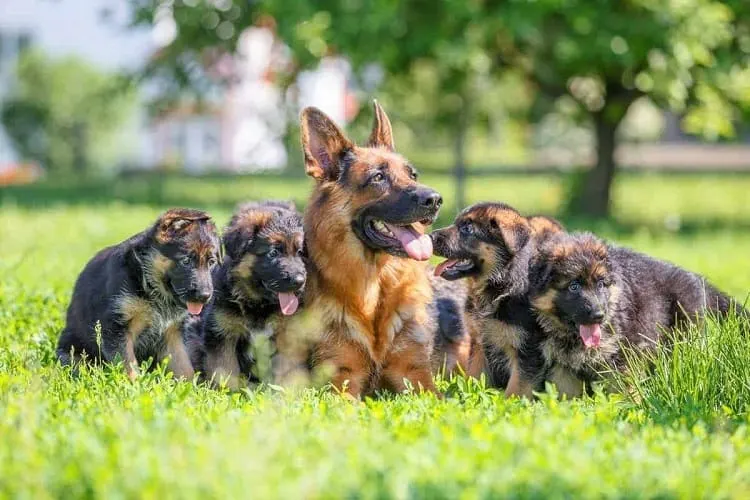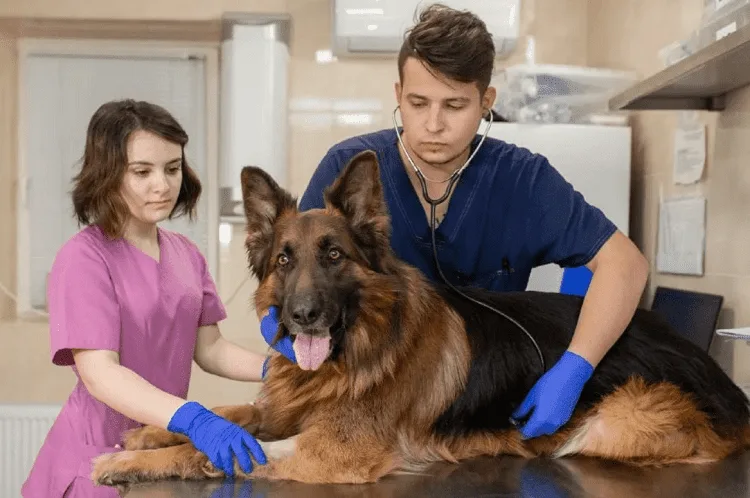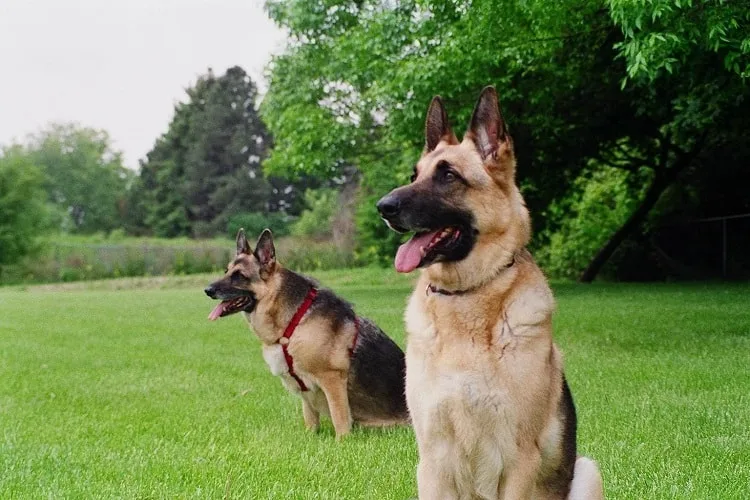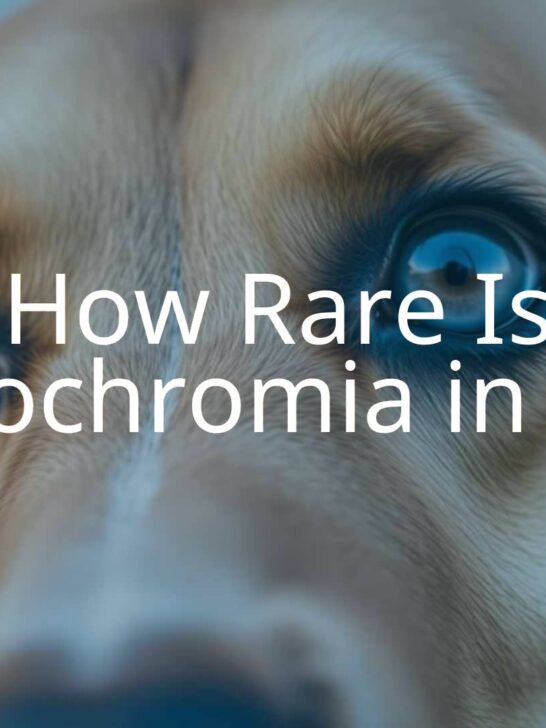How to Breed German Shepherds – Everything You Have to Know
The German Shepherd is one of the most popular dog breeds in the world. It is also a popular choice among dog breeders – earning good money as the demand for purebred pups remains steady.
Breeding German Shepherd dogs can be a daunting and overwhelming task as they have very specific breed standards that must be met.
The show bloodlines or cool black German Shepherds are rare and sought after. There are also various health concerns that affect this breed.
If you wish to know more about this breed, its history, breeding license requirements, and best breeding practices, this handy guide is all you need.
We cover everything you need to know about breeding German Shepherds so you can nurture healthy puppies that meet the breed standard that dog owners will love.
History of German Shepherd Breeding

The German Shepherd dog, or Deutscher Schäferhund, comes from a line of German herding dogs.
In the late 1800s, Captain Max von Stephanitz, a German cavalry officer, began searching for a working dog breed with all the essential qualities of this class.
In 1899, he attended a dog show where he bought a Thuringian Shepherd dog, Verein für Deutsche, and named it Horand von Grafrath.
Horand was the first dog that von Stephanitz registered in his new breed club – The Society of German Shepherds.
Horand was crossed with other breeds of working dogs from Württemberg and Franconia, fathering many puppies, including Hektor von Schwaben, who then sired Beowulf.
Beowulf went on to father more than 80 puppies. The early German Shepherds descended from Horand’s original line.
The wolf-like appearance of the German Shepherd has led many to argue that wolf crosses were also bred into this early gene pool.
However, recent genetic testing has confirmed that German Shepherds do not have wolf DNA.
For the next 35 years, von Stephanitz strived to refine the breed standard of the German Shepherd and promote it as a fine specimen of working dogs.
The sought-after qualities of this breed, such as its intelligence, strength, speed, stealth, agility, loyalty, and beauty, were molded during this time.
In the early 1900s, the breed’s popularity rose in the United States, and it became a sought-after family dog.
This was partly due to the immense popularity of the canine film stars, Strongheart and Rin-Tin-Tin, that served in World War I.
German Shepherds also joined the German military as service dogs during World War II. Today, the German Shepherd is one of the most popular breeds used by police and military units worldwide.
Do You Need a License to Become a Breeder?

Currently, most breeders do not need a license or permit to breed dogs.
However, some states require a permit when a breeder has a certain number of female dogs at the same time or crosses a particular number of litters in a year.
The practice of dog breeding differs between business and commercial breeders. If you wish to become a commercial dog breeder, you will have to apply for a commercial license.
Depending on the state you live in, you must follow certain laws and regulations and meet specific requirements to obtain a permit.
To ensure the legality of your dog breeding business, you must follow certain rules such as the ability to have dogs on your property, the number of dogs you can have at one time, and registering your breeding stock.
You must also obtain a business permit – it will serve as legal proof that your business follows all the laws and regulations of your state.
You must register puppies with a reputed kennel club such as the American Kennel Club. This will allow you to sell your puppies and assure future owners of their health.
Choosing a Puppy

After you’ve attended many dog shows and gained an understanding of what judges look for in German Shepherds, you need to choose a puppy for breeding.
Decide whether you want to breed a show dog or a working dog.
Schutzhund-titled dogs belong to the pedigree of a working dog. Meanwhile, the pedigree of a show dog usually has more American Kennel Club winners.
You also need to look at other factors besides championship titles. Consider the pup’s parents’ health, temperament, conformation, and working ability.
Learn about their history and pedigree through their vet records and other documents. Consider the pup’s parents’ genetic testing results.
They should have been regularly screened for hereditary health concerns, such as hip and elbow dysplasia, degenerative myelopathy, and irritable bowel disease to name only a few.
If you’re getting a puppy from line-breeding, make sure it is between 12 and 14 generations. In line breeding, breeders must ensure that the elbows and hips of several generations of pups are healthy.
Many dog breeders prefer line-breeding as it provides better assurance that all puppies in a litter look alike and have a similar temperament and health to their parents.
If you have any doubts or questions before you purchase a German Shepherd pup, talk to breed experts and consider their input.
At What Age Can You Start Breeding?

Most breeders wish to begin as soon as these dogs enter their heat cycle for the first time.
But a responsible breeder should know that breeding German Shepherds too early can be dangerous for their health. It can also negatively affect the female dog’s parenting ability.
The first heat cycle of a female German Shepherd usually occurs at nine months of age, but they can go into heat as early as six months old.
However, at this age, a female German Shepherd still has the mind and habits of a puppy. It lacks the instincts and maturity to nurture a litter successfully.
And, more importantly, its body is not quite fully developed to bear the stress of pregnancy and lactation.
Ethical breeders start breeding a female dog at two to three years of age. By then, its body and mind will be able to carry and care for healthy litter.
Breeding often stops after a female German Shepherd turns eight. Older female dogs release lower-quality eggs, and there is a greater risk of stillborn puppies.
The sperm of male dogs also deteriorates with age. Regular check-ups will ensure good health of a male dog so it can continue to stud into its tenth year.
Responsible breeders do not use male German shepherds as stud dogs until they have reached sexual maturity.
A stud dog must also conform to the breed standard before it can be used to breed German shepherd dogs.
When to Breed German Shepherds?

Even after a German shepherd dog reaches sexual maturity, a responsible breeder will not use it for breeding until it undergoes the required tests. This practice leads to healthy litters.
Testing German Shepherds for Breeding
A good breeder will have their dog’s elbows and hips graded by the Orthopedic Foundation for Animals (OFA).
This should be done at two years or older to screen for elbow and hip dysplasia. Preliminary evaluations can also be done for dogs over four months to less than two years old.
An ethical breeder will order a degenerative myelopathy test, thyroid panel, Von Willebrand’s Disease test, and OFA eye certification.
If the dog is suffering from or a carrier of a genetic disease or hereditary health issue, it should be treated and removed from the breeding pool.
The average age at which a reputable breeder will breed German shepherd dogs is about two years.
By this time, the dog should have undergone the necessary health clearances and can be certified healthy and free of genetic disorders.
Note that the American Kennel Club does not register puppies from male dogs that were under seven months old or female dogs under eight months of age when they were bred.
Once a female dog is ready for breeding, it must be examined thoroughly by a vet at least one month before breeding. It should be dewormed, updated on shots, and tested for parasites.
It should also undergo a brucellosis test.
German Shepherd Breeding
A female dog enters its heat cycle every six to seven months; on average, it lasts about three weeks.
In the first phase of the heat cycle, called proestrus, a female dog may mark with urine more than usual. You should observe visible swelling and a pinkish discharge.
Male dogs may show interest, but female dogs will not allow them to mount. This stage lasts for one week.
The second stage (estrus) also lasts for about a week. The discharge will become a straw color, which marks the fertile stage when the female dog is more willing and may flirt and play.
It will then lift its tail out of the way and allow a stud dog to mount. During this stage, it is best to allow the dogs to mate every other day. Dog breeders typically take female dogs to the stud dog’s kennel.
If it is not possible to breed German Shepherds naturally, artificial insemination will be done at a vet’s clinic for the first litter.
To register the ensuing litter of puppies produced by artificial insemination, you will need DNA certification.
In the last stage of the cycle, known as diestrus, there is progesterone dominance, and the female dog will no longer be interested in the stud dog.
This is when you should stop breeding dogs until the next heat cycle.
What to Do When Your German Shepherd Is Pregnant?

Most animals stop secreting progesterone when they are not pregnant. However, dogs’ bodies do not recognize the lack of pregnancy and they continue to secrete progesterone for around 60 days.
This poses a challenge when trying to find out if a dog is pregnant or not.
Diagnosing pregnancy in dogs can be done in three ways: palpation, ultrasound, and X-ray.
Palpation can be done 23 to 30 days after ovulation. Pregnancy can be difficult to determine in overweight or very muscled dogs.
An ultrasound can be done from the 21st day after ovulation. It’s a simple method as the dog is not subjected to anesthesia.
It also does not cause pain or discomfort and can be done in the owner’s presence.
X-rays, after the 50th day of ovulation, can help determine the number of fetuses – the heads and spines of the puppies can be counted accurately.
These diagnostic methods must only be performed by qualified vets. It is important to avoid an incorrect diagnosis or even damage to the embryos.
Dog pregnancies last around 63 days. Give your dog a healthy and nutritious diet, ideal for canine pregnancy. This ensures that the dog and pups have all the nutrients they need to remain healthy.
You can determine when a dog will give birth by taking its temperature. For that, you need to insert a lubricated thermometer into its bum.
The average body temperature for dogs is between 101°F and 102.5°F. As the birthing day approaches, its temperature will fall below 99°F, due to decreased serum progesterone levels.
This temperature drop means the dog will go into labor in the next 24 hours.
Early Puppy Care

If there are no complications after whelping, the brand-new litter should be kept warm and comfortable.
You can maintain the ideal temperature using a heating pad controlled by a thermostat or an insulated heating lamp.
For the first five days, keep the temperature between 85°F and 90°F. After a week, the temperature should be 80°F. Set the temperature at 75°F after four weeks.
After the puppies are whelped, they need to nurse the first milk of the mother dog, called colostrum or mother’s gold. This milk contains essential antibodies that protect newborn puppies from diseases.
The mother dog may not eat much during the first few days as it is too busy caring for its puppies. It will keep them warm, stimulate them to urinate and defecate, and clean up their waste.
Monitor the mother dog for complications after birth, such as eclampsia (low calcium levels) and a retained puppy or placenta.
Once the puppies are four weeks old, you can wean them gradually from milk and introduce them to foods. You can easily find puppy mush and gruel recipes online that help with healthy weaning.
Once the puppies are familiar with eating kibble, feed them high-quality dog food that is easily digestible and suitable for growing puppies.
This is important as this large breed is prone to digestive issues. They must also be kept lean and active from a young age.
Weigh the puppies regularly to track their growth and groom them regularly. Additionally, provide them with sufficient socialization and training to ensure a good temperament.
Selling a Puppy

German Shepherd puppies should not be sold until they are at least eight weeks old. During this period, you can interview prospective dog owners to ensure that your pups will go to good, caring homes.
Responsible breeders do not resort to misleading advertising tactics or sell their puppies to puppy mills, pet stores, or wholesale dealers.
Provide prospective dog owners with the puppies’ vet records, health guarantees, feeding instructions, registration papers, return policies, a copy of the sales contract, and other records and documents.
Keep in contact with the new dog owners in case they have any concerns or questions about their new pup. You should also be prepared to take the puppy back if the need arises.
Is Breeding an Expensive Process?

Breeding can be quite expensive, with many expenses involved in breeding pairs and new litters alike.
This is why the most successful and long-running dog breeders are very passionate about the breed and are not out to make money.
A healthy, purebred German Shepherd pup costs between $1,000 and $3,000. Food expenses, health clearances, and genetic testing add up to $300 to $1,000 or higher annually.
Then there are many more pre-breeding tests, along with artificial insemination costs, or stud fees.
If a pregnant dog requires a C-section or there are birth complications, breeding expenses increase significantly.
Breeders also pay registration fees and purchase puppy mush, regular puppy food, vaccinations, and deworming.
Conclusion
Breeding German Shepherds is an incredibly challenging but rewarding job. The work doesn’t end after the birth of the puppies.
Breeders have a thorough knowledge, good ethics, and consistent professionalism.
Whelping healthy litters that stand out as fine specimens of this large breed and are loved by dog owners make the job well worth it!
Resources:




















